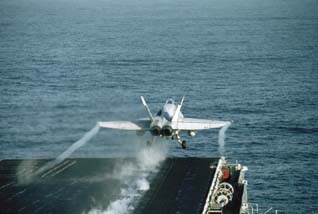|
A jet is taking off from the deck of an aircraft carrier, as Figure 2.12 shows. Starting from rest, the jet is catapulted with a constant acceleration of +31 m/s2 along a straight line and reaches a velocity of +62 m/s. Find the displacement of the jet.
| | Figure 2.12
(a) A plane is being launched from an aircraft carrier. (b) During the launch, a catapult accelerates the jet down the flight deck. (© George Hall/Corbis Images) |
|
Reasoning
The data are as follows:
Jet Data
|
x
|
a
|
v
|
v0
|
t
|
?
|
+31 m/s2
|
+62 m/s
|
0 m/s
|
|
The initial velocity v0 is zero, since the jet starts from rest. The displacement x of the aircraft can be obtained from  , if we can determine the time t during which the plane is being accelerated. But t is controlled by the value of the acceleration. With larger accelerations, the jet reaches its final velocity in shorter times, as can be seen by solving Equation 2.4 (v , if we can determine the time t during which the plane is being accelerated. But t is controlled by the value of the acceleration. With larger accelerations, the jet reaches its final velocity in shorter times, as can be seen by solving Equation 2.4 (v = = v0 v0 + + at) for t. at) for t.
Solution
Solving Equation 2.4 for t, we find
Since the time is now known, the displacement can be found by using Equation 2.7:
 | (2.7) |  |
|
 , if we can determine the time t during which the plane is being accelerated. But t is controlled by the value of the acceleration. With larger accelerations, the jet reaches its final velocity in shorter times, as can be seen by solving Equation 2.4 (v
, if we can determine the time t during which the plane is being accelerated. But t is controlled by the value of the acceleration. With larger accelerations, the jet reaches its final velocity in shorter times, as can be seen by solving Equation 2.4 (v![]() =
=![]() v0
v0![]() +
+![]() at) for t.
at) for t.



